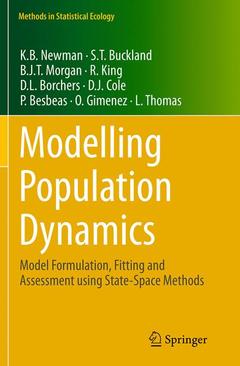Modelling Population Dynamics, Softcover reprint of the original 1st ed. 2014 Model Formulation, Fitting and Assessment using State-Space Methods Methods in Statistical Ecology Series

This book gives a unifying framework for estimating the abundance of open populations: populations subject to births, deaths and movement, given imperfect measurements or samples of the populations. The focus is primarily on populations of vertebrates for which dynamics are typically modelled within the framework of an annual cycle, and for which stochastic variability in the demographic processes is usually modest. Discrete-time models are developed in which animals can be assigned to discrete states such as age class, gender, maturity, population (within a metapopulation), or species (for multi-species models).
The book goes well beyond estimation of abundance, allowing inference on underlying population processes such as birth or recruitment, survival and movement. This requires the formulation and fitting of population dynamics models. The resulting fitted models yield both estimates of abundance and estimates of parameters characterizing the underlying processes.
Introduction.- Matrices as Building Blocks.- State-space Models.- Fitting State-space models.- Model Formulation and Evaluation.- Modelling Population Dynamics Using Closed-population Abundance Estimates.- Estimating Survival Probabilities from Mark-re-encounter Data.- Estimating Abundance from Mark-recapture Data.- Integrated Population Modelling.- Concluding Remarks.
Ken Newman is a mathematical statistician for the United States Fish and Wildlife Service. His primary research interest is in the use of state-space models to model the population dynamics of fish and wildlife to answer scientific questions and to serve as management decision support tools.
Stephen Buckland is Professor of Statistics at the University of St Andrews, and is also Co-Director of the UK National Centre for Statistical Ecology. His interest in modelling population dynamics dates from a project to develop a decision support system for managers of red deer populations in Scotland in the 1990s.
Byron Morgan is Honorary Professorial Research Fellow in the University of Kent, and Co-Director of the National Centre for Statistical Ecology. He is interested in integrated population modelling, which accounts for data collected on different aspects of the demography of wild animals. A convenient component of this work is the use of state-space models for describing ecological time series.
Ruth King is a Reader in Statistics at the University of St Andrews. Her research interests include the development of population dynamics models and model fitting tools in both the classical and Bayesian frameworks. This particularly includes the application of hidden Markov (or state-space) models.
David Borchers is a Reader in Statistics at the University of St Andrews. His research involves developing general statistical models for estimating population density and distribution, integrating hidden state or latent variable models with various kinds of observation model.
Diana Cole is a Senior Lecturer in Statistics at the University of Kent. Her primary research is on parameter redundancy or identifiability of models used in statistical ecology.
Panagiotis Besbeas is a lecturer in the Athens University of Economics and Business, and also a part-time post-doctoral research associate within the National Centre for Statistical Ecology gro
Date de parution : 09-2016
Ouvrage de 215 p.
15.5x23.5 cm
Date de parution : 07-2014
Ouvrage de 215 p.
15.5x23.5 cm



